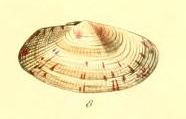Gari costulata
| Gari costulata | ||||||||||||
|---|---|---|---|---|---|---|---|---|---|---|---|---|

Gari costulata |
||||||||||||
| Systematics | ||||||||||||
|
||||||||||||
| Scientific name | ||||||||||||
| Gari costulata | ||||||||||||
| ( Turton , 1822) |
Gari costulata is a type of mussel from the family of sand mussels (Psammobiidae).
features
The flattened housing, which has almost the same flap, is elongated, egg-shaped and up to 26 millimeters long. The right flap is slightly more arched than the left flap. The length / width ratio is about 1.8 to 1.9. The case is unequal, the vertebrae sit slightly in front of the center line (based on the case length). The posterior dorsal margin is straight and only slopes very gently towards the narrowly rounded posterior end, which is set off by two angles. The anterior dorsal margin is slightly convex and merges into the tightly rounded anterior margin. The case has a slight gap at the rear end, but the permanent opening is small. The dark brown ligament sits on the outside and extends only a short distance behind the vertebrae. The lock has two cardinal teeth in both flaps. In the left valve, the anterior cardinal tooth is large and split or two-pointed, while the posterior cardinal tooth is small and thin. In the right valve, the anterior cardinal tooth is larger than the posterior cardinal tooth, both of which are split and bilobed. There are no lateral teeth. The surface line is deeply indented, the U-shaped bay extends below the eddy. The line of the jacket bay coincides with the jacket edge at the lower edge.
The shell is very thin and fragile. The surface shows fine concentric ridges and pits, the annual increase is characterized by deeper pits. In the rear of the case, about 20 ribs extend from the vertebrae to the rear end. The ribbed field is limited by a line that runs from the vertebra to the rear lower corner (transition from the rear to the ventral edge). The color of the shell (inside and outside) ranges from white, yellowish to pink, often with red or purple spots or rays. The yellowish to light brown periostracum is only a thin coating and is often eroded to the edges. The inside edge of the housing is smooth. The inside is glossy white with a pink or purple tint.
The soft body is whitish with a pink tint. The edges of the coat are somewhat thickened and slightly frayed. The animals have a large foot and two very long, separate siphons.
Geographical distribution and habitat
The range of the species stretches from the Faroe Islands southwards over the waters of the British Isles, the coasts of the Eastern Atlantic southwards to Angola . They have also been found in the waters around the Canary Islands , Madeira, and the Azores .
The representatives of the species live buried in muddy sand and gravel from a few meters below the low water line to about 150 meters water depth. The deepest find of this kind, however, was recovered from a depth of 1179 meters. Overall, the animals are rare.
Taxonomy
William Turton was the first author to describe this species under the name Psammobia costulata in 1822 . Today (2016) it is generally recognized in the genus Gari Schumacher, 1817. Psammobia Lamarck, 1818 is a younger synonym of Gari . It is the type species of the subgenus Gari (Psammobella) Gray, 1851, which is also used by some of the authors.
supporting documents
literature
- Fritz Nordsieck: The European sea shells (Bivalvia). From the Arctic Ocean to Cape Verde, the Mediterranean Sea and the Black Sea. 256 pages, Gustav Fischer Verlag, Stuttgart 1969
- Guido Poppe. Yoshihiro Goto: European Seashells Volume 2 (Scaphopoda, Bivalvia, Cephalopoda) . 221 pp., Verlag Christa Hemmen, Wiesbaden 1993 (2000 unc. Reprint), ISBN 3-925919-10-4 (p. 114)
- Paul Chambers (with figures from George Sowerby): British Seashells: A Guide for Collectors and Beachcombers. 233 pp., Remember When, Barnsley Yorkshire, 2009 ISBN 978-1-84468-051-1 Preview on Google Books (p. 172)
On-line
Individual evidence
- ^ William Turton: Conchylia insularum Britannicarum. The shells of the British islands. 279 pp., London, MA Nattali, 1822 Online at www.biodiversitylibrary.org (p. 87)
- ↑ MolluscaBase: Gari costulata (Turton, 1822)